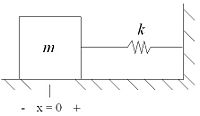Laplace transforms:Mass-Spring Oscillator: Difference between revisions
No edit summary |
No edit summary |
||
| Line 73: | Line 73: | ||
Now using the relationship below, we are able to compute the value of ''b'': |
|||
<math>\frac{b}{m}=2\zeta w_n</math> |
|||
Now we can go ahead and put in the values that we know from the problem statement which gives us: |
|||
<math>b=\left\{(2)(.146)(10.5)(98.1)\right\}=300.775</math> |
|||
When we plug this number into the Laplace transform equation: |
|||
<math>\mathbf{X}(s)=\frac{\frac{1}{m}}{\left\{s^2+\frac{b}{m}s+\frac{k}{m}\right\}} </math> |
|||
Revision as of 18:42, 22 October 2009
Problem Statement
Part 1
An ideal mass m=10kg is sitting on a plane, attached to a rigid surface via a spring. The spring with k=10.8 kN/m is exerting zero force when the mass is centered at x=0. Between the mass and plane there is a 1 mm layer of a viscous fluid. Find the equation of motion that the spring mass system follows if there is an initial impulse applied, and then find the kinematic viscosity value of the fluid so that the mass comes to a stop within three seconds with the initial impulse used.
As set up, the mass is sitting at x=0 with positive being to the right. Velocity is positive to the right as well.
Part 2
Apply the Initial Value and Final Value Theorems to this problem.
Part 3
Make a bode plot.
Solution
Part 1
First, a FBR:
By Newton's first law:
math>\mathbf{F}=m{a} 21:28, 22 October 2009 (UTC) \Rightarrow 21:28, 22 October 2009 (UTC) \mathbf{f}_m(t)=m\ddot{x}</math>
By Hooke's law:
math>\mathbf{F}=k{x} 21:28, 22 October 2009 (UTC) \Rightarrow 21:28, 22 October 2009 (UTC) \mathbf{f}_k(t)=kx</math>
Now we set up our equation of motion:
We now have a second order differential equation that governs the motion of the mass. If we make our initial conditions equal to zero, we save a few steps. Taking the Laplace transform of both sides gives:
Now that we have the Laplace transform of the differential equation that governs the motion of the spring and mass system, we need to solve for X(s):
We now have the function in terms of X(s). We will use the above equation to help in part 3, but for now we want to continue with part 1. We now want to find the value of b so that the mass stops oscillating after t=3s. However, we know that it will never actually be zero until a long time after, so for now we will consider motion >2% of original to be stopped. The below formula helps us find the value of b:
Now using the relationship below, we are able to compute the value of b:
When we plug this number into the Laplace transform equation:
We know from Laplace transforms that:
From this we know that we are going to have two parts to our solution, and sine wave and a cosine wave. We can also tell that:
Once we get the Laplace transform into the correct form, we have:
Now we take the inverse Laplace transform:
Now that we are back in the time domain we just add the two parts together and we have:
So we have found the equation that governs the motion of the spring mass system, all that is left is putting in constants for the variables to find numerical answers for any problem of this type.
Part 2
The Initial Value Theorem states:
So if we plug our equation into this we have:
As expected, the Initial Value Theorem shows us that the initial value is just the initial x value.
The Final Value Theorem States:
It seems as though the Final Value Theorem predicts the final result to be 0. However, in this case, the function is an oscillating one, and the prediction is telling us the average, which is 0. So, in this case the Final Value Theorem is not used to its full potential.
Written by: David Steinweg
Checked by: Nathan Reeves





























